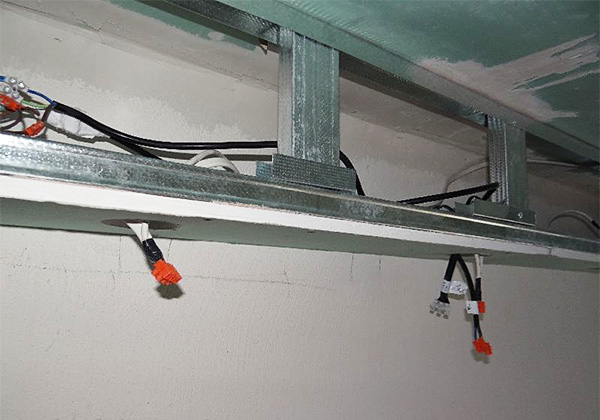Repairing the ceiling in the bathroom requires the selection of special building materials, because the use of this room occurs daily, which means that there is constant moisture and temperature changes in it. Excessive humidity can deteriorate the appearance of the ceiling beyond recognition.
Let's try to figure out all the existing options for bathroom ceilings, determine their characteristics, cost and complexity in execution.
The main requirements for the ceiling in the bathroom
When creating coziness in the bathroom and choosing the type of ceiling for a given room, the following factors must be taken into account:
Having dealt with the main requirements for the ceiling in the bathroom, you can consider the existing options and choose a more suitable type, and there are several of them:
- putty and painting;
- plastic panels;
- rack type ceiling;
- suspended ceiling using plasterboard;
- modular (divided into tiled and mirror);
- stretch.
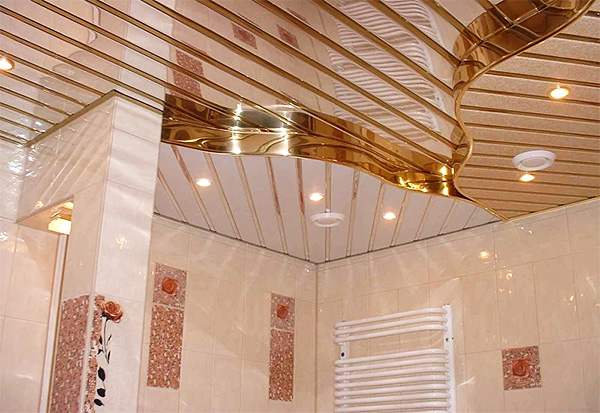
Combination of curly plasterboard and slatted ceiling
Whitewashing and painting the ceiling in the bathroom
Whitewashing or painting the ceiling is considered the most affordable and cost-effective way, in addition, all repair work can be done independently, without involving specialists in the process. All you need for work is a roller, primer, paint or whitewash. In case the ceiling is not completely flat, a putty may be required to level the surface.
Important. All finishing materials (primer, putty and paint) are purchased only waterproof. This will help to avoid rapid destruction of the painted layer.
In the case when there are significant differences between the ceiling tiles, it is better to choose a different type of ceiling, since leveling the surface with putty will be a labor-intensive process.

Whitewashing the ceiling in apartments is now extremely rare.
The features of this ceiling, which can be considered both a disadvantage and an advantage, are as follows:
- such a solution with a surface is not distinguished by its originality, but the situation can be corrected by experimenting with several colors at the same time and applying them in various bold compositions;
- with a well-chosen high-quality finishing material, the service life exceeds 5 years;
- painting the ceiling does not require complex maintenance, although it quickly absorbs various contaminants, and paint that has darkened from time to time can always be refreshed with a new layer;
- built-in lighting will have to be abandoned, but a good alternative can be those that can successfully emphasize the interior of the room;
- there is no opportunity to hide various communications under the ceiling, but if they break, you will not need to disassemble part of the ceiling;
- painted ceilings more than all other options are exposed to the growth of mold and various fungal masses on them.
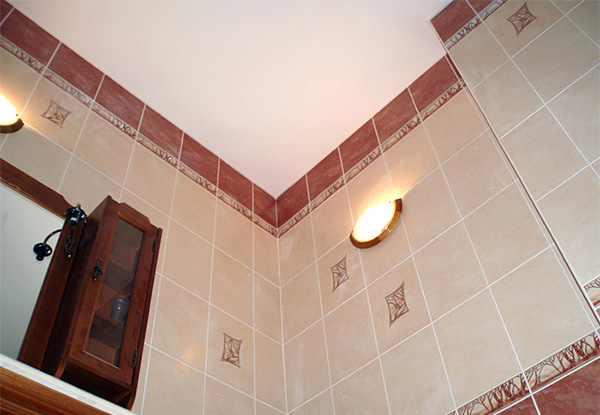
Painting the ceiling in the bathroom
To whitewash the ceiling, use lime or chalk white, but water-based paint will look best. It is the latter option that gives the ceiling a beautiful and delicate look, but processing the ceiling in this way will be more expensive than using a lime mortar.
The ceiling is painted in the following stages:
- The surface is being prepared. For this, the tiles are cleaned and leveled. Ceiling cleaning depends on the future and previous treatment composition. For example, if before there was just lime, but now you want to use a chalk solution, the previous layer must be removed.
- The use of water-based paint also requires the removal of the previous coat.
- The next step is to apply a layer of primer with a roller, while remembering that all subsequent work occurs only after the surface is completely dry.
- The painting material is applied in 2-3 layers using a roller.
Important. For the bathroom, the primer must be purchased with an anti-fungal effect. In the future, this will help to avoid the formation of mold.
Plastic panels for the ceiling in the bathroom
Often a good and inexpensive solution for a bathroom ceiling is the installation of plastic panels. Of course, compared to painting, this option is slightly more expensive, but it has its own advantages:
- does not require additional finishing;
- has a good appearance;
- the possibility of self-mounting;
- It does not require special care;
- the design allows you to create spot lighting;
- the ability to hide existing irregularities on the surface;
- masking of various communications from above.
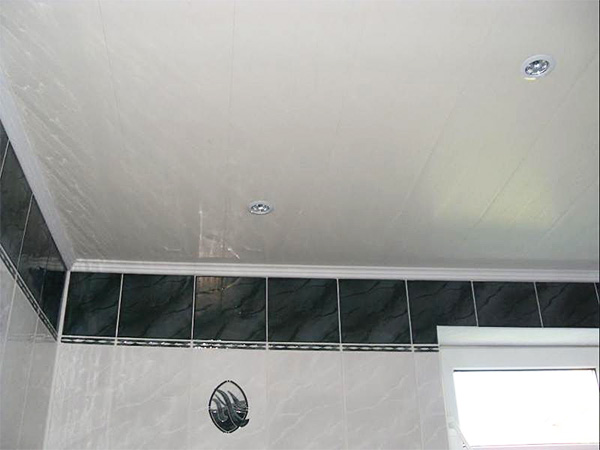
Plain plastic panels on the ceiling in the bathroom
The available disadvantages of plastic panels:
- The seams that are available on some types of panels become clogged with dirt over time and do not look very aesthetically pleasing, although the problem is solved by cleaning. The situation is worse when the bathroom is poorly ventilated. Then in these seams fungus can grow, which is removed much worse.
- The second problem can be the frame on which the tiles are attached. Even in the case of a galvanized coating, rust cannot be avoided in case of increased humidity in the room.
- Renovating the ceiling will require time-consuming dismantling, which will require removing all of the old plastic.

The frame sets the desired height to the tile, hides the duct and wiring
First of all, for the installation of plastic panels, you will need to make a frame, which is assembled from metal profiles. For the frame, an option is also possible with wooden beams, the section of which will be 50x40 or 50x50 mm.
Important. In the case when the choice was stopped on wooden beams, one must not forget to process them for stability in a humid environment.
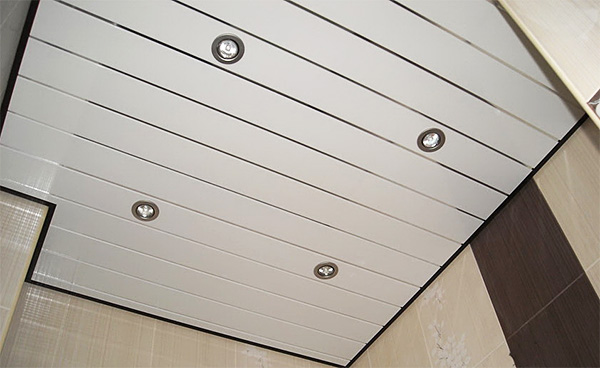
False ceiling in the bathroom
With a large ceiling area, the frame may sag in the central part over time. This will be facilitated by the weight of the entire tile. To avoid these problems in the future, you can use suspensions that are used when working with material such as drywall.
When buying panels and a frame, you will need to purchase ceiling plinths and corners, and when calculating the number of panels themselves, you will need to take a couple of more of them. This will avoid going back to the store if one of the panels is damaged during installation or trimming.
Slatted ceiling in the bathroom
(just like the previous version) is assembled on a pre-made frame, only instead of panels, slats are attached to it. The slats themselves are a type of long panel that can be made from a material such as steel, aluminum or plastic.
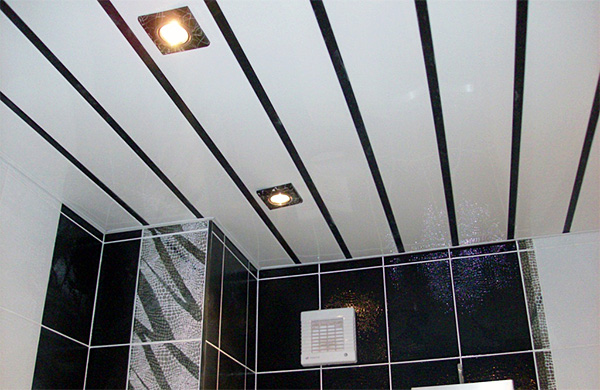
Contrast of white and black slats
Of all the types, I would like to note the aluminum version of the rails. They are more resistant to water and corrosion. The color scheme will not be a problem for the buyer either. Manufacturers produce panels in different colors: chrome, gold-plated, patterned and monochromatic.
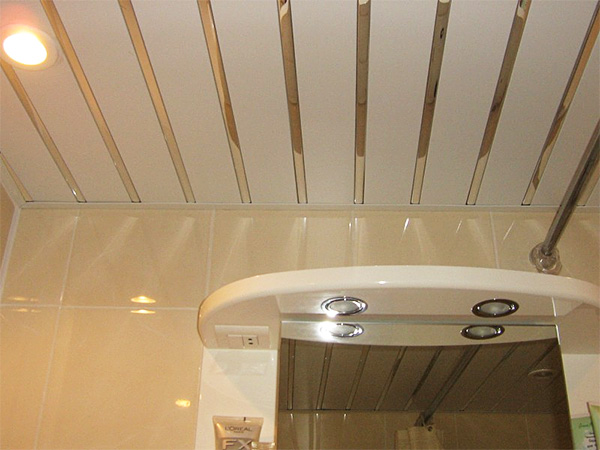
Combination of white slats and gold accents
Maintenance of the slatted ceiling will not be difficult and depends on the type of products, which are divided into three types:
- the open type of slats provides for a small space between them, but it is more suitable for ceilings of at least 5 meters in height;
- the closed type of slats in appearance resembles a lining;
- the third view is the same as the first (open), but the entire space between the slats is closed with special inserts.
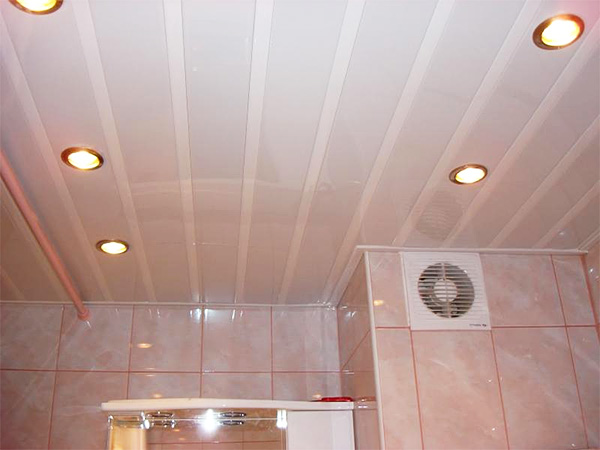
White slats and white inserts
Important. When buying rails, pay attention to the protective film coating. Its absence indicates a fake product.
The disadvantages of such a ceiling include debris that occurs at the seams of the slats and the fact that this option is not suitable for every interior of the room.
Plasterboard suspended ceiling for bathtub
Plasterboard for the bathroom is one of the most expensive materials, although it is better for all other options to hide the unevenness and inaccuracies of the ceiling. Before deciding on such a ceiling, it is better to consider other options several times. And yet, if there is no way out, then it is worth considering several rules, the observance of which will help such a ceiling to last as long as possible without repair:
- Plasterboard must be purchased moisture-resistant and impregnated with special additives, which will prevent the cultivation of the fungus. The manufacturer produces such a greenish product with a specific GKLV marking. Such material is more resistant to dampness, decay and less crumbling.
- You will need to take care of good ventilation, not only in the room itself, but also over drywall.
- It is good if a special hydro-barrier is made. To create it, small grooves are made in the walls, along which, in the event of a flood from above, the water will go to the sides along the walls, less exposing the ceiling to moisture.

Shaped plasterboard construction
Installation features
